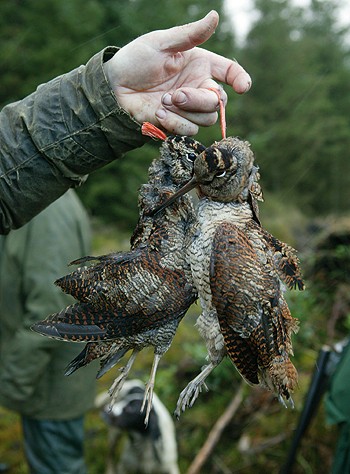Country Diary: Woodcock shooting

Get on to the subject of shooting woodcock and opinions invariably differ. I?ve heard some supporters of woodcock shooting denounce fellow Guns for declining an opportunity to shoot one, citing correctly that there?s no evidence to suggest that shooting pressure is affecting the UK wintering population as a whole.
As a roughshooting woodcock aficionado myself, I?ve pawed through the available evidence and support this argument, but I?d never use it to encourage more people to shoot them. I have more time for the sportsman who consciously declines an opportunity to bag a woodcock, than I do for less considerate Guns who put them in the bag, simply because the rules allow it.
The majority of woodcock flushed on shoot days have made arduous journeys to get here from breeding grounds in northern Europe and beyond, as shown by the Game & Wildlife Conservation Trust?s (GWCT) research on woodcock migration. As a sportsman, my conscience demands that I?m respectful of a woodcock?s momentous travelling habits, and that I should have good reasons for wanting to shoot one. For me, that?s straightforward: I adore the flavour and texture of woodcock meat, and I?m content that the half-dozen birds that I typically take in December and January each season, won?t jeopardise the population that inhabits the thousands of acres of woodland that I shoot over.
Respectful rituals
I?m not the least bit embarrassed to say that, after admiring the stunning, forest-floor markings of their tawny capes, I?ll typically salute a woodcock that I?ve shot with a kiss, before carefully placing it in my gamebag. These birds are dear to me and I cherish each one that I shoot, never taking my right to do so for granted. Shooting in Cornwall last year, I noticed a neighbouring Gun, whom I?d never shot with before, treat a woodcock in the same way. There was no need to pass comment on his ritual: it simply rubber-stamped the fact that I was in good company.
Recently, I had a disturbing conversation with a Dorset-based gamekeeper, who no longer allows woodcock to be shot on driven days. Tim manages a low-ground shoot, where released pheasants provide the mainstay of the sport. His ground is blessed with hundreds of acres of damp oak woodland and shrubby cover, which supports good numbers of woodcock in a typical winter, and many more during a hard one. His decree that woodcock were now off-limits on shoot days was met with disapproval by disgruntled syndicate members, but he?s stuck by his decision. To my surprise, it wasn?t concerns regarding over-exploitation that instigated Tim?s moratorium: it?s because he disliked Guns showing no interest in taking home woodcock they?d shot. Of course he can take woodcock to the gamedealer ? he can get good money for them ? but that wasn?t his point. Why should he permit Guns to shoot woodcock on his patch, if they?re not also prepared to take the birds home to eat or at least give them to someone else to enjoy?
Half a century ago, after removing the pin feathers of a shot bird, it was considered good etiquette for the lucky Gun also to remove the woodcock?s legs below the knee and draw its sinews, as a nod to the bird?s delectable thigh meat. The tradition of ?legging? a woodcock has waned, and in its place we now have Guns who take no culinary interest in birds they?ve killed. I dare say that this sad state of affairs has crept in from the commercialisation of our sport. I gave Tim my heartiest support, and thanked him for making a stand.
In my view, we need an industry-recognised code of practice on woodcock shooting, to prevent over-exploitation and to deter poor sportsmanship. While I think its principles should focus on science-based guidelines for sustainable harvests of woodcock at local, regional and global levels, I?d like to see it include frank guidance on the ethics behind shooting woodcock. ?Don?t shoot one, unless you want to eat it, or you know someone who does,? would make an appropriate maxim. It would make sense for the code to cover other migratory wader quarry species, such as snipe and golden plover.
Except under special circumstances, it is illegal to sell a dead wild goose in the UK. The absence of a commercial market for shot geese is intended to prevent over-exploitation of what is predominantly a winter migrant population. For duck, the advice given by BASC in its Club and Syndicate Affiliation Guide is clear: ?No member shall sell or be engaged in the sale of shot migratory wildfowl or cause others to sell such shot wildfowl on his behalf.? Isn?t it time that BASC?s stance on migratory wildfowl sales was extended to migratory waders, and adopted by the whole shooting community? I think it is.








